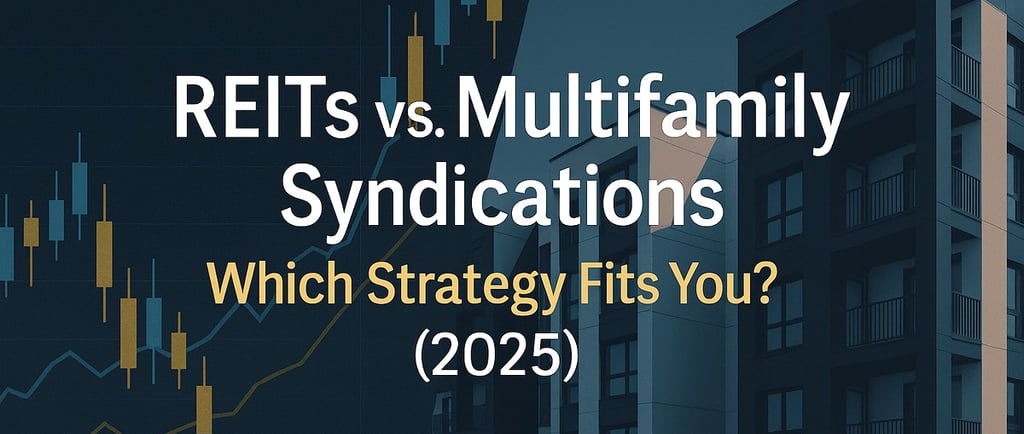REITs vs. Multifamily Syndications (2025): Which Strategy Fits You?
Side-by-side comparison of REITs and Multifamily Syndications.
Published by E&S Properties
9/17/20254 min read


REITs vs. Multifamily Syndications (2025): Which Strategy Fits You?
Your guide to choosing between publicly traded REITs and private multifamily syndications—what’s changed in 2025 and how to build a balanced strategy.
Executive summary
REITs: Liquid, low minimums, professionally managed. Dividends are ordinary income, but qualified REIT dividends also receive a 20% §199A deduction under current 2025 law.
Syndications: Illiquid (3–7 years) and higher minimums, but offer direct ownership benefits, depreciation, cost segregation, and 100% bonus depreciation for qualifying post‑Jan 19, 2025 assets—potentially boosting early tax losses.
Balanced approach: Use REITs for liquidity and education; use syndications for tax‑efficient cash flow and targeted value‑add upside.
REITs: the stock‑market path to real estate
What they are. Real Estate Investment Trusts are companies that own, operate, or finance income‑producing real estate. By rule, REITs must distribute at least 90% of taxable income to shareholders as dividends.
How they work. You buy and sell shares in a brokerage account like any stock. Management teams handle acquisitions, operations, and dispositions across sectors (apartments, industrial, data centers, healthcare, etc.).
Where REITs shine
Liquidity & access: Trade intraday; start with a single share.
Diversification: One ticker can represent hundreds of assets across markets.
Income & long‑run returns: Historically competitive total returns (~9–10% annualized over long horizons), driven by steady dividends plus appreciation.
Tax note (2025)
REIT dividends are generally ordinary income, but most individual investors can also deduct 20% of qualified REIT dividends under §199A. Holding REITs in tax‑advantaged accounts can further improve after‑tax outcomes.
Trade‑offs
Stock‑market correlation: Prices move with equity sentiment and interest rates.
No control: You don’t select the properties or business plans.
Fee layer: Corporate expenses are paid before dividends.
Multifamily syndications: direct ownership without being the landlord
What they are. Multiple investors (Limited Partners) pool capital in an LLC/LP to acquire an apartment community. The sponsor/General Partner sources the deal, arranges debt, manages CapEx and operations, reports, and executes the exit.
Why investors choose syndications
Direct ownership benefits: Share in cash flow, amortization, and appreciation.
Powerful tax shield: Depreciation—often accelerated via cost segregation—and 100% bonus depreciation for qualifying assets placed in service after Jan 19, 2025 can significantly shelter cash flow.
Inflation alignment: Rents can reset annually; value is tied to NOI, not the S&P 500.
What to watch
Illiquidity: Typical holds of 3–7 years with few early‑exit paths.
Sponsor risk: Outcomes hinge on execution quality.
Minimums & accreditation: Many offerings require $50k–$100k and accredited‑investor status (or sophistication under specific exemptions).
1031 reality check: Exchanges generally occur at the property level. Investors usually cannot 1031 their LP/LLC interests on exit (DST/TIC structures are exceptions designed for exchange‑friendliness).
Side‑by‑side comparison
Minimums & access: REITs—one share; Syndications—larger checks, diligence on sponsor & deal.
Liquidity: REITs—daily; Syndications—none until refi or sale.
Taxes: REITs—ordinary income less the §199A 20% deduction for qualified dividends; Syndications—depreciation, cost seg, and 100% bonus depreciation for qualifying 2025+ assets.
Return pattern: REITs—broad‑market; Syndications—deal‑by‑deal, with value‑add targeting mid‑teens to ~20% IRR when executed well.
Quick value‑add case study
Property: 250‑unit garden community
Purchase price: $25.0M
In‑place rents/occupancy: $1,000 avg; 85% occupied
24‑month plan
Professionalize ops + leasing → occupancy to 92%
Light turns + curb appeal: $3,000/unit (~$750k)
Re‑mark rents to $1,150 avg
Back‑of‑the‑envelope impact
Gross rent lift (simplified): $150 × 250 × 12 = $450,000/yr
Value creation at a 6.0% exit cap: $7.5M (450,000 ÷ 0.06)
Cap‑rate sensitivity: 5.5% → ~$8.18M; 6.5% → ~$6.92M
Note: NOI lift will be lower than $450k after OpEx; model taxes, reserves, and non‑rent income. Add DSCR and rate‑stress to your underwriting.
Risk snapshot & mitigation
REIT risks
Equity‑market volatility; rate sensitivity; sector concentration.
Mitigate: diversify across sectors/ETFs; focus on stronger balance sheets; mind the rate regime.
Syndication risks
Sponsor execution; illiquidity; business‑plan risk.
Mitigate: underwrite the operator, not just the deal; diversify across markets and vintages; keep non‑deal liquidity for life events.
Putting it to work in a portfolio
If you need liquidity or want to start small: REITs are the on‑ramp.
If you want tax‑efficient cash flow & direct value creation: Syndications fit—especially with 100% bonus depreciation back for qualifying 2025+ assets.
Balanced allocation idea: 5–10% to REITs for liquidity; 10–20% to syndications for targeted, tax‑efficient upside (size to your risk, timeline, and income).
How E&S Properties invests
Focus: Value‑add multifamily in growth markets with durable demand.
Discipline: Conservative underwriting (realistic rent growth, exit‑cap buffers, rate/DSCR stress tests).
Execution: Tight asset management, transparent reporting, and clear pre/post‑CapEx KPIs.
Ready to take the next step?
🔎 Ready to take the next step?
📩 Sign up for our newsletter to get weekly insights on current trends.
📝 Interested in investing? Complete our investor questionnaire and we’ll be in touch with opportunities that match your goals.
Notes & references
REITs must distribute ≥90% of taxable income: IRS Instructions for Form 1120-REIT (2024)
Long-run REIT returns and market data: Nareit REIT Index Returns
§199A deduction for qualified REIT dividends (continuation under 2025 law): DLA Piper — REIT Tax News (Sep 2025)
100% bonus depreciation restored (qualifying property placed in service after Jan 19, 2025): Wipfli (Aug 28, 2025)
1031 exchanges: partnership/LLC interests generally not eligible: IRS Fact Sheet FS-2008-18
Texas net in-migration pace (context for Sun Belt demand): Texas Demographic Center (July 2025)
This material is for education only and not tax, legal, or investment advice. Consult your advisors.
© 2025 E&S Properties. All rights reserved.
